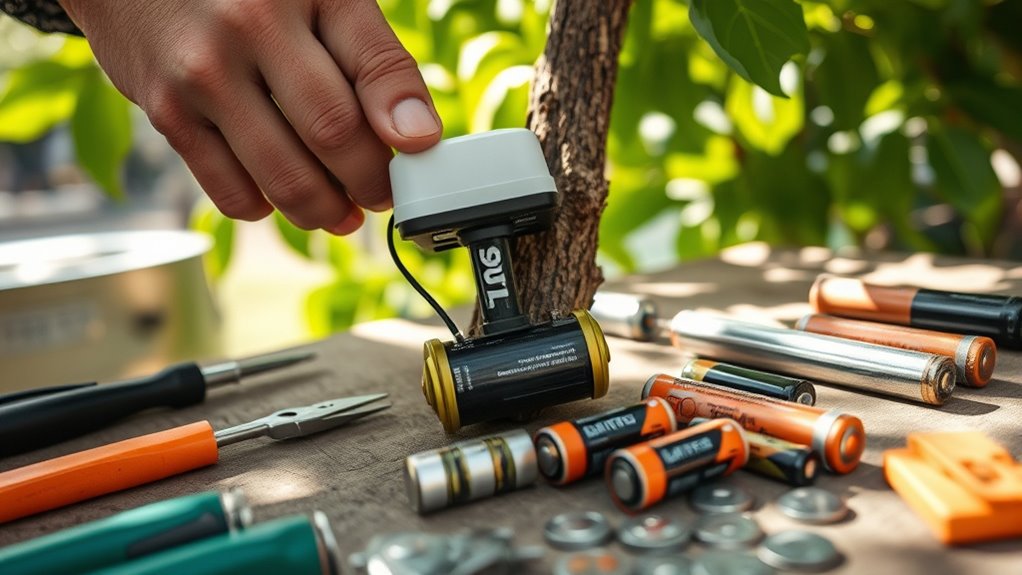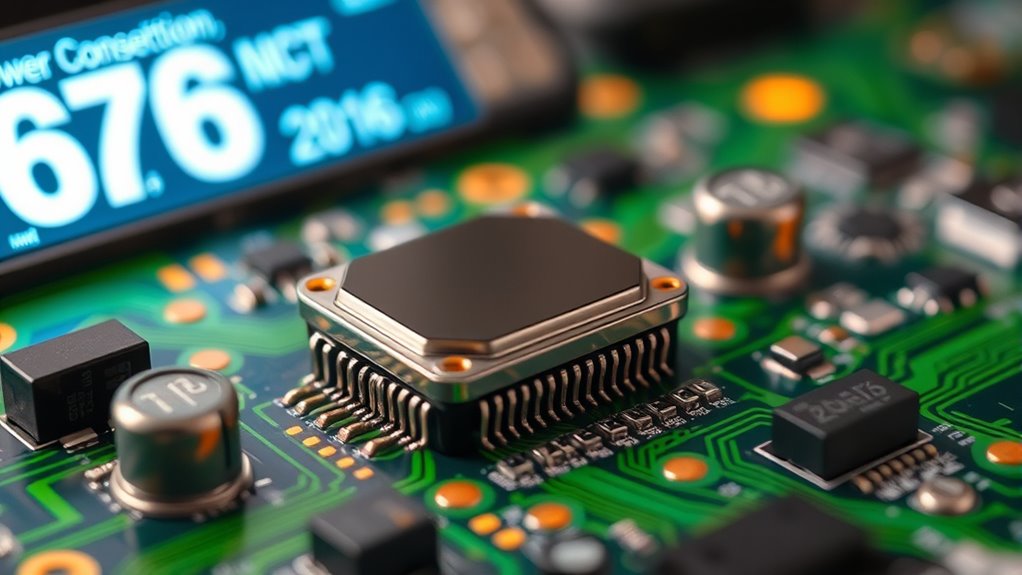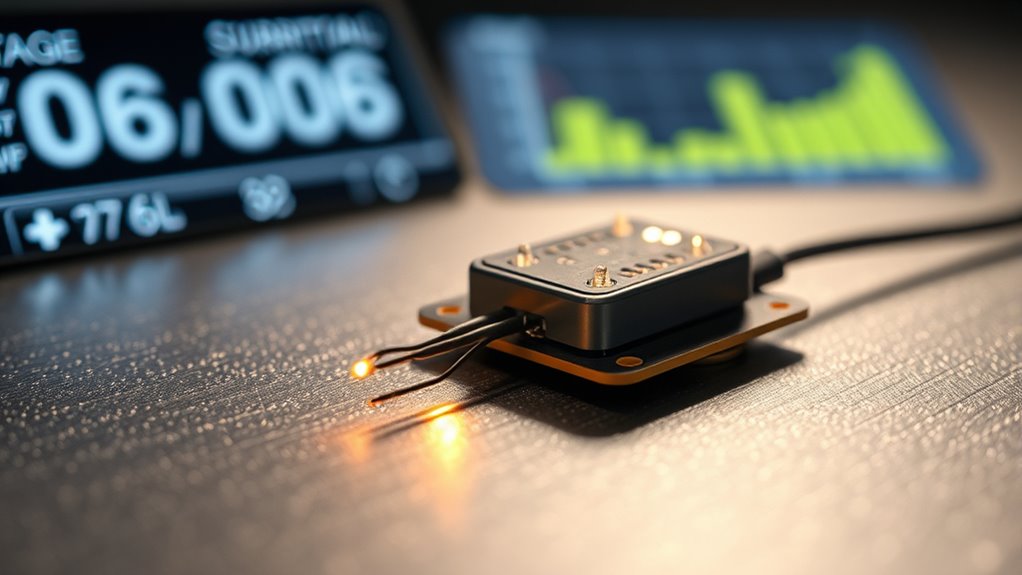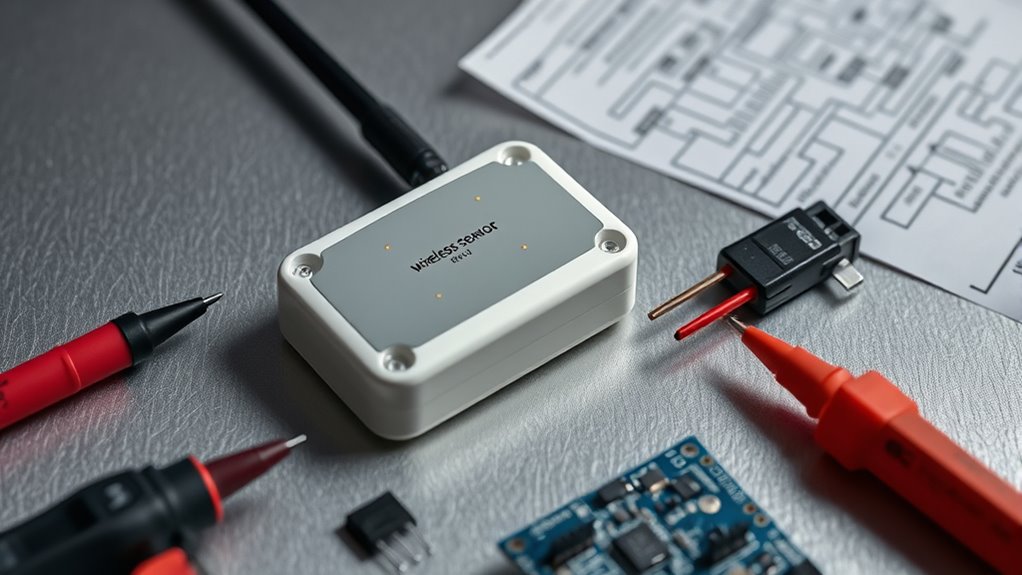To manage batteries effectively for wireless sensors, choose the right type and capacity based on your environment and energy needs. Implement power-efficient hardware and software practices like duty cycling, low-power microcontrollers, and energy harvesting. Regularly monitor voltage and performance to predict when replacements are needed. Optimize sensor operation and schedule proactive maintenance to extend lifespan. Keep these strategies in mind, and you’ll release long-lasting, reliable sensor performance—more tips await to help you succeed.
Key Takeaways
- Select appropriate battery types and capacities based on sensor energy needs and environmental conditions.
- Implement low-power hardware and software strategies, like sleep modes and duty cycling, to extend battery life.
- Regularly monitor voltage and performance data to predict battery aging and schedule timely replacements.
- Optimize sensor duty cycles and utilize energy harvesting to reduce power consumption during operation.
- Establish proactive maintenance and replacement schedules to ensure reliability and prevent system downtime.
Selecting the Right Battery Type and Capacity

Choosing the right battery type and capacity is essential for guaranteeing your wireless sensors operate reliably over their intended lifespan. Your choice of battery chemistry impacts performance, longevity, and safety, so consider options like lithium-ion, alkaline, or nickel-metal hydride based on your sensor’s power needs and environmental conditions. Capacity planning is equally critical; selecting a battery with sufficient capacity ensures your sensors won’t frequently run out of power, reducing maintenance and downtime. You need to assess your sensor’s energy consumption patterns and expected operational period to determine the appropriate capacity. Proper selection prevents premature battery failure and optimizes operational efficiency. Additionally, understanding environmental considerations such as temperature ranges and potential exposure to elements helps ensure the battery performs optimally in outdoor or challenging conditions. By carefully evaluating battery chemistry and capacity, you set a strong foundation for a dependable, long-lasting wireless sensor system.
Implementing Power-Efficient Hardware and Software Strategies

To maximize your wireless sensors’ battery life, implementing power-efficient hardware and software strategies is essential. Use hardware with low power consumption, such as energy-efficient microcontrollers and optimized sensors. Software should include sleep modes, duty cycling, and adaptive sampling to reduce active time. Prioritize wireless security by enabling data encryption efficiently, avoiding unnecessary transmissions that drain power. Visualize these strategies with this table:
| Hardware Strategies | Software Strategies | Security & Encryption |
|---|---|---|
| Low-power microcontrollers | Duty cycling sensors | Efficient data encryption |
| Energy-efficient sensors | Sleep modes | Secure wireless security |
| Power management ICs | Adaptive sampling | Minimize data transmissions |
| Hardware-based power save | Event-driven updates | Authentication protocols |
| Optimized antenna design | Data compression | End-to-end encryption |
Implementing robust security protocols ensures that power savings do not compromise data integrity and confidentiality. These approaches considerably extend battery life while maintaining security.
Monitoring and Predicting Battery Performance

Have you ever wondered how to accurately monitor and forecast your wireless sensor’s battery life? Tracking battery aging is essential, as it impacts overall performance and lifespan. Regularly measuring voltage stability helps identify early signs of degradation, allowing you to anticipate failures before they occur. Using battery management systems or data logging tools, you can gather real-time voltage data and observe trends over time. Monitoring changes in voltage fluctuations reveals how well the battery maintains its capacity, highlighting potential issues. By analyzing these patterns, you can predict when your battery will need replacement or recharging. Implementing proper calibration techniques ensures your measurements remain accurate over time. This proactive approach ensures your sensor operates reliably and prevents unexpected downtime due to battery failure. Accurate monitoring and prediction are key to optimizing sensor longevity and maintaining system efficiency.
Optimizing Sensor Operation and Duty Cycles

Optimizing sensor operation and duty cycles is essential for extending battery life and ensuring reliable performance. By carefully scheduling sensor activity, you minimize energy consumption during idle periods. Incorporate energy harvesting techniques to supplement power, reducing reliance on batteries alone. Adjust duty cycles so sensors wake only when necessary, balancing data collection needs with power savings. Efficient wireless communication protocols also help conserve energy by reducing transmission time and avoiding unnecessary data exchanges. Consider implementing adaptive duty cycles that respond to environmental conditions or sensor data trends, further optimizing energy use. Additionally, understanding the Kia Tuning concepts related to performance upgrades can inspire innovative ways to optimize sensor systems for better efficiency and durability. This approach extends sensor lifespan, lowers maintenance costs, and enhances system reliability. Ultimately, thoughtful management of operation schedules and communication strategies maximizes battery efficiency and system uptime.
Ensuring Proper Maintenance and Replacement Procedures

Regular maintenance and timely replacement of sensor batteries are crucial to guarantee continuous system performance. To ensure this, you should follow a structured approach:
- Establish clear replacement schedules, based on battery lifespan and sensor usage patterns, to prevent unexpected failures.
- Implement proper battery recycling practices, disposing of used batteries responsibly to protect the environment.
- Regularly inspect sensors for signs of battery degradation, and replace batteries proactively to maintain accuracy and reliability.
- Staying informed about battery longevity can help optimize replacement timing and reduce downtime.
Frequently Asked Questions
How Do Environmental Factors Affect Battery Lifespan in Wireless Sensors?
Environmental factors like temperature effects and moisture impact directly influence your wireless sensor’s battery lifespan. High temperatures accelerate chemical reactions inside batteries, causing faster degradation, while low temperatures can reduce capacity temporarily. Excess moisture can lead to corrosion and short circuits, damaging the battery. You should monitor and control these environmental conditions to extend your sensor’s battery life, ensuring reliable performance and reducing maintenance needs over time.
What Are the Cost Implications of Different Battery Management Strategies?
Think of your battery management strategies as the steady drumbeat guiding your sensor’s lifespan. With smart cost optimization, you diminish expenses by avoiding unnecessary replacements, while effective maintenance scheduling keeps the system humming smoothly. This balanced approach minimizes costs over time, transforming your energy management from a gamble into a well-orchestrated symphony. By fine-tuning these strategies, you guarantee your wireless sensors stay reliable without draining your budget.
Can Renewable Energy Sources Be Integrated Into Sensor Battery Systems?
You can integrate renewable energy sources into sensor battery systems through renewable integration and energy harvesting techniques. This approach allows your sensors to harness ambient energy, like solar or vibrational sources, reducing reliance on traditional batteries. By implementing energy harvesting, you extend sensor lifespan and enhance sustainability. This integration requires careful planning to guarantee efficient energy collection and storage, ultimately making your wireless sensor networks more autonomous and environmentally friendly.
How Do Sensor Network Topologies Influence Battery Consumption?
Your sensor topology considerably influences energy efficiency and battery consumption. A centralized topology may drain batteries faster due to increased communication loads, while a mesh network spreads energy use more evenly. By choosing the right topology, you can optimize data transmission paths, reduce unnecessary communication, and extend sensor battery life. Properly managing your sensor network’s topology helps conserve energy, ensuring longer-lasting sensors and more reliable data collection.
What Are Emerging Trends in Wireless Sensor Battery Technology?
You should keep an eye on emerging trends like solid state batteries and energy harvesting. Solid state batteries offer higher energy density and improved safety, extending your sensor’s lifespan. Energy harvesting techniques, such as solar or vibrational energy, enable your sensors to generate power from their environment, reducing reliance on traditional batteries. Together, these advancements help you create more sustainable, longer-lasting wireless sensor networks, minimizing maintenance and boosting overall efficiency.
Conclusion
By following these battery management best practices, you’ll keep your wireless sensors running smoothly like a well-oiled machine. Choosing the right batteries, optimizing power use, and staying vigilant with maintenance are your keys to longevity. Think of your sensors as a delicate dance—each step matters. When you master these strategies, you’ll guarantee your system stays energized and reliable, preventing unexpected shutdowns and turning your sensor network into a resilient backbone for your operations.







